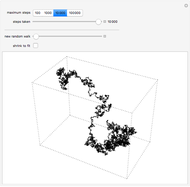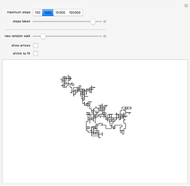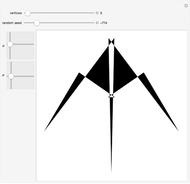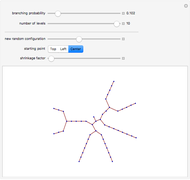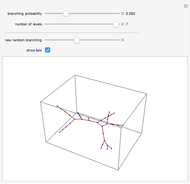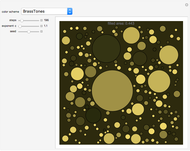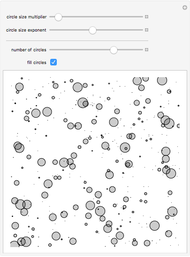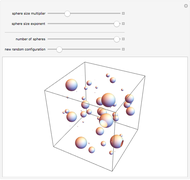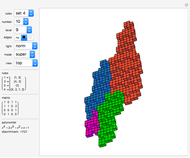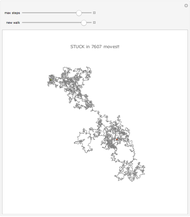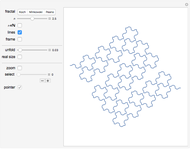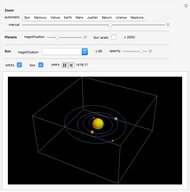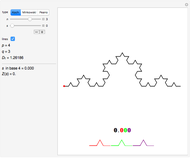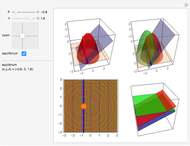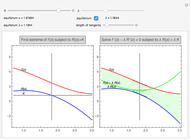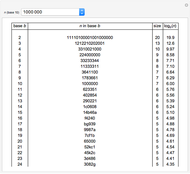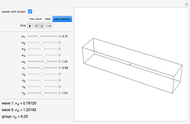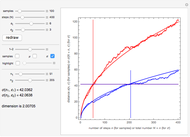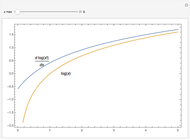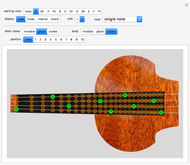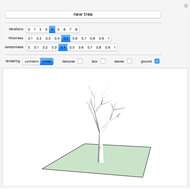A 1D Random Walk with Fractal Dimension 2.0

Requires a Wolfram Notebook System
Interact on desktop, mobile and cloud with the free Wolfram Player or other Wolfram Language products.
This Demonstration shows a 1D random walk with fractal dimension 2 retrieved from a numerical experiment. You can get an intuitive insight into how a fractal function of dimension 2 behaves with varying resolution. These functions are extremely important, as they have been shown to be the geometrical foundation of quantum behavior [1].
Contributed by: Cedric Voisin (July 2012)
Open content licensed under CC BY-NC-SA
Snapshots
Details
This Demonstration illustrates the random walk property  where
where  is the dispersion,
is the dispersion,  is the number of steps, and
is the number of steps, and  is the size of a step. The relation
is the size of a step. The relation  ,
,  a constant, is here shown to be the signature of a fractal dimension equal to 2.
a constant, is here shown to be the signature of a fractal dimension equal to 2.
The fractal dimension of an object is the power that links the number  of smaller objects used to measure it and their typical length
of smaller objects used to measure it and their typical length  , which is called the resolution.
, which is called the resolution.
When  is known, then the fractal dimension
is known, then the fractal dimension  is by definition
is by definition  , where
, where  is an arbitrary resolution of reference. It can be written
is an arbitrary resolution of reference. It can be written  (the constant
(the constant  is fixed by the arbitrary chosen reference
is fixed by the arbitrary chosen reference  ). The object of reference might be chosen to be the whole main object itself, so that
). The object of reference might be chosen to be the whole main object itself, so that  ,
,  , and the definition becomes
, and the definition becomes  .
.
Once this law is known, any dimensional measure of the object can be computed: length in  , surface in
, surface in  , volume in
, volume in  , "Koch-measure" in
, "Koch-measure" in  , or any
, or any  measure in
measure in  , where
, where  is a dimension of reference (the fractal dimension of the measuring object). In general, the
is a dimension of reference (the fractal dimension of the measuring object). In general, the  measure is only finite when
measure is only finite when  ; it tends to 0 when
; it tends to 0 when  and to
and to  when
when  (e.g., a Koch curve has infinite length, null surface, and constant "Koch-measure" measured in
(e.g., a Koch curve has infinite length, null surface, and constant "Koch-measure" measured in  ). The general law is given by
). The general law is given by  , where
, where  is the
is the  measure. As
measure. As  , it is clear that the sign of
, it is clear that the sign of  gives the limit of the
gives the limit of the  measure (0, constant, or infinite). In other words, at infinite resolution, an object has a finite, non-null measure only when measured in its own (fractal) dimension.
measure (0, constant, or infinite). In other words, at infinite resolution, an object has a finite, non-null measure only when measured in its own (fractal) dimension.
In the case of the usual self-similar fractals, the relation  is given recursively by the generator of the fractal, for instance
is given recursively by the generator of the fractal, for instance  for the Koch curve, which, once paired with the definition of
for the Koch curve, which, once paired with the definition of  ,
,  , gives
, gives  and hence
and hence  .
.
But the case of a random walk is different because it is a nondeterministic process, so there is no generator and the curve is not even unique. Nevertheless, it is possible to get the needed relation  by statistical means: it is the very definition of the dispersion
by statistical means: it is the very definition of the dispersion  . It then becomes possible to get the dimension of a random curve statistically. The hidden order lies in the rules used to generate the walk: equal probability for each direction and independence of each trial (Markov process).
. It then becomes possible to get the dimension of a random curve statistically. The hidden order lies in the rules used to generate the walk: equal probability for each direction and independence of each trial (Markov process).
Here, the needed relation is obtained by imposing that  is constant, which amounts to fixing a reference object
is constant, which amounts to fixing a reference object  , for example, the distance between two fixed points. This is consistent with the meaning of the dispersion
, for example, the distance between two fixed points. This is consistent with the meaning of the dispersion  , which is the mean departure away from the mean value (here
, which is the mean departure away from the mean value (here  ) and can be thought of as the mean displacement of the drunken sailor. That
) and can be thought of as the mean displacement of the drunken sailor. That  is constant can now be understood as the signature of a fractal dimension 2.
is constant can now be understood as the signature of a fractal dimension 2.
In this Demonstration, two sets of random walks with two different resolutions (step sizes)  and
and  are computed with their statistical properties
are computed with their statistical properties  and
and  .
.
You can choose the number of samples, the number  of steps, and the two resolutions
of steps, and the two resolutions  and
and  . The "redraw" button recomputes new samples with the new chosen values. You can display all the samples (large numbers of samples or steps may be slow on some computers), the mean functions
. The "redraw" button recomputes new samples with the new chosen values. You can display all the samples (large numbers of samples or steps may be slow on some computers), the mean functions  (with their theoretical value:
(with their theoretical value:  ), and the
), and the  functions (with their theoretical values:
functions (with their theoretical values:  ).
).
The 1-2 slider lets you choose to look at only one set or both and the "highlight" checkbox highlights one sample that you can select with the corresponding slider (this may help to compare individual samples with different resolutions).
When adjusting the sliders  and
and  so that
so that  , you can check that the computed dimension
, you can check that the computed dimension  is around 2, with an error depending on how far the experimental
is around 2, with an error depending on how far the experimental  's are from their theoretical values (the more samples, the smaller the error).
's are from their theoretical values (the more samples, the smaller the error).
The intuitive meaning of all this is that when you compare two random walks at two different resolutions (between two fixed points, here  and
and  ), each step contains (on average)
), each step contains (on average)  steps
steps  times smaller. You need four small steps to make one step two times larger, nine small steps to make one step three times larger, and so on. Another way to see it is to consider the displacement
times smaller. You need four small steps to make one step two times larger, nine small steps to make one step three times larger, and so on. Another way to see it is to consider the displacement  as a new step of size
as a new step of size  , which contains
, which contains  steps
steps  , but is only
, but is only  times larger.
times larger.
If the fractal dimension of the random walk is unknown from theory, this Demonstration lets you retrieve it by numerical experiment.
Understanding fractal dimensions and fractal functions is particularly important in the light of Laurent Nottale's scale relativity [1], where the spacetime coordinates are functions of their resolutions (and hence are fractal curves). The dimension 2 is especially important, as it has been shown (first by Feynman [2]) that each (fractal) spacetime coordinate acquires dimension 2 at the quantum scale.
References
[1] L. Nottale, Scale Relativity and Fractal Space-Time, London: Imperial College Press, 2011.
[2] R. Feynman and A. Hibbs, Quantum Mechanics and Path Integrals, New York: McGraw–Hill, 1965.
Permanent Citation






